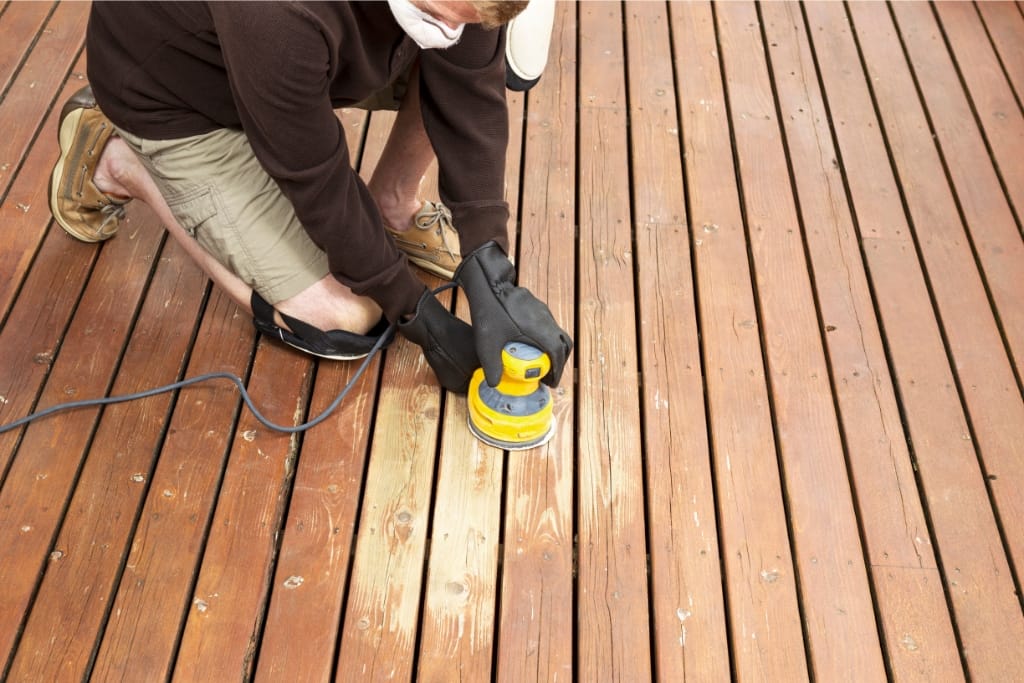Wood decks are a great addition to any home. They provide a warm and inviting outdoor space for entertainment or relaxation on warm summer days and even chilly nights.
However, just like any other outdoor structure, they require maintenance to keep them in tip-top shape.
When it comes to maintaining your deck, there are a few key things to keep in mind that will help keep your deck looking beautiful and lasting for years to come.
Check out our top 10 wood deck maintenance tips for longevity and beauty.
1)) Regular Cleaning
Regular cleaning is important to remove dirt, debris, and organic matter, such as leaves and moss, from the surface of the deck.
These materials can cause the wood to rot over time, or even root below and around the deck.
You can use a power washer for a quick and efficient clean, or use a deck brush with a mild cleaner to gently scrub the surface.
Tips for Effective Regular Cleaning:
- Use the Right Tools: Investing in a high-quality deck brush with stiff bristles will make the cleaning process more effective. For stubborn dirt, consider using a power washer but be careful not to damage the wood.
- Choose a Suitable Cleaner: Not all cleaners are safe for wood decks. Opt for a mild, wood-friendly cleaner to avoid damaging the surface. Always dilute the cleaner as directed on the packaging.
- Regular Inspections: Regularly inspect your deck for any signs of mold, mildew, or rot. Early detection can prevent further damage and make the cleaning process easier. If you spot any, treat these areas first before proceeding with general cleaning.
Regular cleaning is not just about maintaining the aesthetic appeal of your wood deck; it's a necessary measure to prolong its lifespan.
By using the right tools, choosing suitable cleaners, and conducting regular inspections, you can prevent early wear and tear, and ensure your deck remains a beautiful and welcoming space for years to come.
2)) Inspection
Always inspect your deck for damage and make any necessary repairs as soon as possible.
Look for loose or protruding nails or screws, cracked or splintered boards, or any signs of rot.
These problems can only worsen if left unattended, leading to serious safety issues.
Tips for Thorough Deck Inspections:
- Spot the Small Signs: Be attentive to small signs of damage like loose nails, splintered boards, or cracks. These little issues can quickly escalate if ignored, leading to more extensive damage.
- Check for Rot: Pay particular attention to areas that are prone to moisture, such as underneath the deck, as these are the most likely places for rot to occur. Use a screwdriver to probe the wood; if it's soft and easy to penetrate, it might be rotting.
- Hire a Professional: If you're uncertain about the structural integrity of your deck, it's best to hire a professional. An expert will be able to accurately assess the state of your deck and recommend any necessary repairs.
Regular and thorough inspections are crucial to prolonging the lifespan and ensuring the safety of your deck.
Understanding the signs of damage, regularly checking for rot, and seeking professional help when necessary are all integral parts of this process.
By staying vigilant and timely addressing any issues, you can maintain the structural integrity of your deck and enjoy its beauty and functionality for years to come.
3)) Staining And Sealing
Staining and sealing your deck will help protect it from the elements and keep it looking great.
Stain can help to protect against the sun's UV rays, while a sealant helps to repel water.
Both are important to keep your deck in tip-top shape while making it look great.
Tips for Successful Staining and Sealing:
- Choose Quality Products: Invest in high-quality stains and sealants that provide UV protection and water repellency. A good product will protect your deck from weathering and extend its lifespan.
- Prepare the Surface: Before applying the stain and sealant, make sure your deck is clean and dry. Any dirt or moisture can affect the adhesion of these products to the wood, reducing their effectiveness.
- Follow the Instructions: Each product has specific instructions regarding application and drying time. Follow these carefully to ensure the best protection for your deck. Typically, it's advised to apply the stain and sealant when the weather is clear and dry.
Staining and sealing are critical steps in maintaining the overall aesthetics and durability of your deck.
Deciding on top-quality products, proper deck preparation, and adhering to the product's instructions are all key to achieving excellent results.
The effort you put into staining and sealing not only enhances your deck's appearance but also significantly contributes to its long-term preservation against harsh weather conditions.
4)) Pay Attention To Drainage
Proper drainage is important to ensure that water doesn't collect on the deck's surface and lead to water damage.
Water that collects can cause rot and other damage to the boards.
To remedy this, make sure that your deck is sloped correctly, and that any water drains away from the house.
Tips for Ensuring Proper Deck Drainage:
- Ensure Correct Slope: The deck should have a slight slope to facilitate the runoff of rainwater. If you see puddles forming after rain, it may be time to adjust the slope.
- Clean Gutters and Drains: Keep the gutters and drains near your deck clear of leaves and debris. This helps prevent water from overflowing onto your deck and causing water damage.
- Inspect for Damage Regularly: Regularly check the deck for signs of water damage, such as peeling paint or warped wood. Early detection can prevent costly repairs down the line.
Paying attention to drainage is an essential part of deck maintenance.
Ensuring the correct slope, keeping gutters and drains clean, and regularly inspecting for water damage can all help to prevent water build-up and subsequent damage.
By being proactive in these areas, you can significantly extend the life of your deck and maintain its safe and functional use for many outdoor seasons to come.
5)) Trim Surrounding Foliage
Make sure that surrounding trees and foliage are trimmed properly and aren't touching or damaging your deck.
Not only can falling branches or overgrown foliage land on and damage your deck, but they can also contribute to an environment that is perfect for insects to thrive.
Tips for Effective Trimming of Surrounding Foliage:
- Regular Pruning: Prune trees and shrubs near your deck regularly to prevent overgrowth that can cause damage. This also allows more sunlight to reach your deck, helping to prevent a damp environment that can encourage rot and insect infestation.
- Maintain a Safe Distance: Keep a safe distance between your deck and the foliage. If possible, have at least a few feet of clear space between your deck and the nearest plants. This reduces the risk of plant-related damage and deters small animals from accessing your deck.
- Inspect for Pests: When trimming the foliage, take the opportunity to inspect for any signs of pests. Insects can cause significant damage to your deck if left unchecked. If you notice any signs of infestation, consider calling a professional pest control service.
Proper management of surrounding foliage is an often-overlooked, but crucial aspect of deck maintenance.
Regular pruning, maintaining a safe distance between the deck and plants, and vigilant pest inspection can significantly reduce the risk of damage to your deck.
By staying proactive in your approach to foliage management, you can ensure that your deck remains a safe and comfortable outdoor living space for years to come.
6)) Fix Structural Issues
Structural issues can cause your deck to become unstable or unsafe.
Whether it's posts or beams that have weakened over time or railings that are rusted, it's important to take care of these issues as soon as possible before they become bigger and more expensive problems to fix.
Tips for Addressing Deck Structural Issues:
- Regular Inspections: Conduct periodic inspections of your deck's structure, looking for signs of wear and tear, rust, or damage. Catching problems early can prevent them from escalating into major, costlier issues.
- Consulting Professionals: If you find any problems during your inspection, it's often best to consult a professional. They can accurately assess the severity of the issue and recommend the best course of action.
- Investing in Quality Materials: When repairing or replacing parts of your deck's structure, invest in quality materials that are durable and weather-resistant. This can extend the lifespan of your deck and minimize future structural issues.
Addressing structural issues promptly and effectively is a key aspect of deck maintenance.
Regular inspections, professional consultations, and investment in high-quality materials can help maintain the safety and longevity of your deck.
By being proactive and vigilant in managing these issues, you can ensure that your deck remains a robust and enjoyable extension of your living space for many years.
7)) Remove And Repair Stains
Accidents happen, and sometimes stains can be left on your deck from food, grease, or even spills from your grill.
Be sure to clean up any spills as soon as they happen to avoid staining.
However, if you do get a stubborn stain, there are many products available to help remove stains and restore the natural beauty of your deck.
Tips for Removing and Repairing Deck Stains:
- Immediate Action: Respond promptly to spills on your deck. The faster you clean up a spill, the less likely it is to leave a stain. Use a mild soap and warm water for initial clean-up.
- Use Deck Cleaning Solutions: For stubborn stains, use a specialized deck cleaning solution. Always follow the manufacturer's instructions when using these products.
- Regular Maintenance: Regularly sweep and wash your deck. This not only helps to prevent stains from setting in but also maintains the overall cleanliness and aesthetic appeal of your deck.
Effectively removing and repairing stains is crucial to maintaining the appearance and longevity of your deck.
By promptly addressing spills, using appropriate cleaning solutions for stubborn stains, and staying committed to regular maintenance, you can keep your deck looking its best.
A well-maintained deck not only enhances the aesthetic appeal of your home but also provides a welcoming space for outdoor enjoyment.
8)) Use A Rug Or Mat
Using a rug or mat on your deck will help protect it from scratches, furniture that is often moved around, or anything heavy that is likely to rub directly against the wood.
Make sure it is made of a material that doesn't trap moisture or cause damage to the wood underneath it.
Tips for Using a Rug or Mat on Your Deck:
- Choose Wisely: Select a rug or mat specifically designed for outdoor use. These are typically made of materials that resist moisture and sun damage, and they won't trap water against the deck surface.
- Proper Positioning: Place the rug or mat strategically to protect high-traffic areas or under furniture that is moved frequently. This can reduce wear and tear on your deck.
- Regular Cleaning: Clean your rug or mat regularly to prevent the build-up of dirt and grime, which could cause damage over time. Also, occasionally remove the rug or mat to allow the deck underneath to dry fully. This can prevent moisture-related damage to your deck's surface.
Utilizing a rugthe or mat on your deck is an effective way to prevent unnecessary wear and tear.
By choosing suitable outdoor materials, positioning the rug strategically, and maintaining regular cleaning procedures, you can extend the life of your deck.
Allow the deck underneath to dry fully to avoid any moisture-related damage.
Indeed, a small addition like a rug can make a significant difference in preserving your deck's quality and appearance.
9)) Avoid Pressure Washing
While pressure washing is an easy and efficient way to clean decking, it can also be dangerous if not done correctly.
High-pressure water can cause damage and even splinter the wood or force water into the cracks between boards and allow for water to stand which can cause premature rotting. Use a lower-pressure setting or standard hose instead.
Tips for Cleaning Your Deck Without Pressure Washing:
- Use a Garden Hose: Use a standard garden hose with a spray attachment for regular cleaning. This is less harsh on your deck but still effective for removing dirt and grime.
- Apply a Gentle Deck Cleaner: Choose a deck cleaner suitable for your deck's material. Apply this gently with a brush or broom, following the manufacturer's instructions.
- Try a Soft Scrub Brush: For stubborn dirt, use a soft scrub brush. This can help remove dirt without damaging the surface of your deck. Always scrub in the direction of the wood grain to avoid damage.
While pressure washing may seem like a quick solution for cleaning your deck, it can cause more harm than good if not done appropriately.
Opting for gentler approaches such as using a garden hose, applying a deck cleaner, or employing a soft scrub brush can effectively clean your deck without risking damage.
Always remember, that proper deck maintenance prioritizes preserving the integrity of the wood over convenience, ensuring the longevity and aesthetics of your outdoor space.
10)) Schedule Regular Maintenance Routines
One of the biggest things you can do to keep your deck looking beautiful and lasting for years to come is to schedule regular maintenance.
Whether it's an annual inspection or a bi-annual cleaning, ensuring you stay on top of the necessary care can save you time and money in the long run.
Tips for Scheduling Regular Maintenance Routines for Your Deck:
- Set a Schedule: Determine a maintenance schedule that suits your lifestyle and the needs of your deck. This could be a monthly, quarterly, or annual routine.
- Routine Inspection: Regularly inspect your deck for any signs of damage or wear and tear. Look out for loose boards, protruding nails, or signs of rot. Early detection of these issues can save you time and costs in repairs.
- Stay Consistent: Consistency is key when it comes to deck maintenance. Once you've established a routine, stick to it. Regular maintenance can prevent minor issues from becoming major problems over time.
Scheduling regular maintenance routines is an important commitment in ensuring the durability and longevity of your deck.
By setting a personalized maintenance schedule, routinely inspecting for potential issues, and sticking to this consistent routine, you can prevent major problems before they occur, saving you time and money.
A well-maintained deck remains inviting and beautiful, enhancing your outdoor living experience for many years to come.
Conclusion
Maintaining the beauty and integrity of your deck requires mindful practices and regular care.
From selecting the right materials to cleaning techniques and preventative measures, each plays a critical role in preserving your deck's quality and enhancing its lifespan.
Remember that an outdoor deck is a significant investment, and thus, it's worth taking the time to maintain it properly.
By following these tips and scheduling regular maintenance routines, you can enjoy your outdoor space for many years to come.
It's more than just a deck, it's an extension of your living space and a place to create memories; treat it with the care it deserves.
Related Articles and Guides:
- How To Clean A Wood Deck
- How To Clean A Wood Deck Without A Pressure Washer
- How To Clean A Wood Deck Naturally
- How To Power Wash A Wood Deck
- 10 FAQs About How To Clean A Wooden Deck
Download Our Free E-book!








